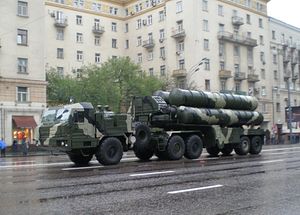China and Taiwan are both primed to invest heavily in air and missile defense systems in the coming years.
On the one hand, there have been more and more signs that China will become the first foreign customer of Russia’s most advanced anti-missile system, the S-400. China’s People’s Liberation Army already operates the Russian-made S-300 anti-missile system, and Beijing and Moscow have reportedly been negotiating over the S-400 since 2010. These talks have reportedly been slowed by a number of issues, including Russia’s concern that China would reverse-engineer the advanced anti-air and anti-missile system.
As The Diplomat noted back in April, the two sides have reportedly made progress on overcoming these issues this year, and Russian media outlets have reported that Russian President Vladimir Putin has approved in principle the sale of between two and four S-400 air and missile defense systems to China.
This was all but confirmed last month by Sergei Ivanov– formerly, Russia’s defense minister and deputy prime minister, and currently Putin’s chief of staff. Speaking to state media outlets in Russia, Ivanov said “The chances that China may be the first foreign buyer [of S-400s] are high.”
Acquiring S-400s would significantly strengthen China’s missile and air defense capabilities. Paul N. Schwartz, a fellow at the Center for Strategic and International Studies (CSIS) in Washington, has noted that, “Although it is a derivative of the S-300, the S-400 represents a significant upgrade in nearly all respects.”
Indeed, according to the South China Morning Post, “the S-400 can engage up to 36 targets simultaneously with as many as 72 missiles at altitudes of five metres to 30 km.” It also has a range of 400 km, roughly four times the range of the S-300. Moreover, SCMP also notes that the S-400 is capable of engaging nearly all conceivable air threats, including, “tactical and strategic aircraft, ballistic missiles and hypersonic targets such as the U.S.’ F-35 fighter jet.”
No country would be as threatened by China’s acquisition of the S-400 as Taiwan. As Defense News noted earlier this year, “At present, China’s land-based mobile air defense missile systems, HQ-9 and S-300 can reach only a small sliver of northwestern Taiwan….However, with the planned purchase of the 400-kilometer-range Russian S-400 surface-to-air missile (SAM) system, China will for the first time have complete air defense coverage of Taiwan.”
Discussing the implications of this for Taiwan’s defense, York Chen, a former member of Taiwan’s National Security Council, told Defense News: “When S-400s work together with Chinese land- and sea-based fighters, the Chinese will have more confidence in sustaining airspace dominance over the Taiwan theater, thus depriving any organized resistance by the Taiwan Air Force and deterring the American intervention.”
Taiwan is likely to respond to this is in a number of ways, including pressing the U.S. for F-35 Joint Strike Fighters, ramping up production of cruise missiles, and possibly seeking ballistic missiles. Some have even speculated that Taiwan will forward deploy special operation forces closer to the mainland, who would be tasked with trying to destroy China’s S-400 systems at the beginning of a conflict.
At the same time, Taiwan is also ramping up its own spending on air and missile defense systems to deal with China’s cruise missiles and especially its growing stable of stealth fighters. Taiwan’s Defense Ministry recently submitted a new defense budget to members of parliament. One Taiwanese lawmaker told the press on Saturday that the proposed budget includes a substantial investment to replace Taiwan’s aging Hawk air-to-surface missile defense systems with the much more modern Tien Kung III (Sky Bow III).
Specifically, the Taiwanese Defense Ministry is asking for $2.5 billion between 2015-2024 to replace the Hawk systems with the Sky Bow-3. The lawmaker claimed that this was the largest purchase of a domestically-made system in recent years.
The Sky Bow III should be a substantial upgrade for Taiwan’s defense against China’s ever present cruise missile threat to the island nation. More notably, however, it should help Taiwan cope with the threat posed by China’s emerging J-20 stealth fighter jets. Kao Hua-Chu, Taiwan’s defense minister until last year, told lawmakers in 2011 that the Sky Bow III will be capable of dealing with the J-20 as long as it is equipped with an advance radar system.

































